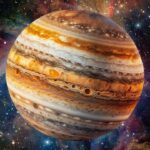
📷 Image Credits: hindustantimes.com
NASA’s James Webb Space Telescope has made a groundbreaking discovery capturing a phenomenon that astronomers have long hoped to witness directly. The Near-Infrared Camera on the telescope has captured an intriguing group of protostellar outflows in the Serpens Nebula, shedding light on how stars are born. These aligned objects, seen with exceptional spatial resolution and sensitivity in near-infrared wavelengths, provide insights into the fundamental processes of star formation. The discovery marks a significant milestone in understanding the birth of stars.
As clouds collapse to form stars, astronomers have traditionally assumed that the stars will spin in the same direction. However, the alignment of the stellar jets observed by the Webb Telescope reveals a different reality. The aligned, elongated structures signify the historical record of how stars come into existence, offering a unique perspective on this cosmic phenomenon.
The Webb Telescope’s image of the Serpens Nebula unveils the presence of bright clumpy streaks, indicating shockwaves from jets hitting surrounding gas and dust. This area, known as Serpens North, offers a clear view of extremely young stars and their outflows, providing crucial data that was previously invisible in optical wavelengths due to thick dust.
Astronomers are now delving deeper into the chemical makeup of the cloud using Webb’s Near-Infrared Spectrograph. By investigating volatile compounds such as water and carbon monoxide, the team aims to understand the origins of the matter that forms stars and planets. These findings will contribute to our understanding of how unique circumstances influenced the formation of our solar system billions of years ago.
The Webb Telescope continues to unravel mysteries in our solar system and beyond, exploring distant worlds around other stars while probing the origins of the universe. With this latest discovery in star formation, the telescope showcases its unparalleled capacity to capture groundbreaking images and advance scientific knowledge. Stay tuned for more insights from NASA’s cutting-edge space observatory on HeadlineFly.com.







